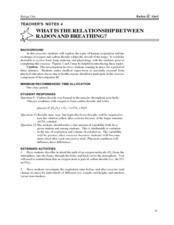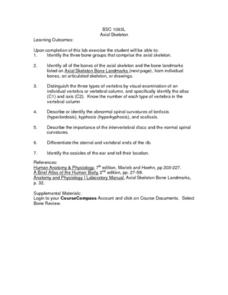Curated OER
Seeing in 3D: Interpreting Two-Dimensional Diagrams of Three-Dimensional Objects
Students hone in on their skills at reading diagrams. In this dimensional activity students collect information on the functions of organs then figure out how all the parts work together.
Curated OER
Leonardo da Vinci
Students select appropriate tools and technology to perform tests, collect data, and display data. They construct appropriate graphs from data and develop qualitative statements about the relationships between variables.
Curated OER
Dinosaur Tracks: From Stride To Leg Length To Speed
Students determine the relationship between leg length, stride length, and speed in humans and bipedal dinosaurs. They collect data and graph these human characteristics then use actual data collected from dinosaur track pads and fossils...
Curated OER
Adaptations of Fishes for Survival in Polar Environments
Students compare the anatomy of temperature and polar fishes. They explore the adverse effects of cold on metabolism and physiology and discuss how polar fishes adapt to their environments. Comparisons are also made to the DNA sequences...
Curated OER
Starfish
Students explore the concept of starfish. In this starfish lesson, students identify the parts of a starfish and how their body works. Students create a starfish using paint and a cornmeal mixture. They then glue on Cheerios to...
Curated OER
Amphibians-Frog Dissection
Students compare the anatomy of a fish to an amphibian and that of an amphibian (frog) to a human. They complete a virtual frog dissection to gain some experience prior to the real dissection.
Curated OER
Heart 1: Transplant
Pupils explain the workings and anatomy of the heart and to explore new medical techniques that help people live longer, healthier lives.
Curated OER
The Cardiac 100
Pupils make a full scale diagram. In this heart and blood flow instructional activity, students pretend they must design the cardiac 100 racecourse and they must teach the new blood cells how to get around the heart. Pupils create a mini...
Curated OER
How We Learn About the Brain: Teaching the Infant Brain
Young scholars describe the development of an infant from conception to birth. In this biology lesson, students discover how a child's brain develop. They explain how children acquire motor and cognitive skills.
Curated OER
Sheep Brain Dissection
Students study the brain and examine what the functions of the major functions are. In this investigative lesson students dissect a sheep's brain and note the similarities and differences between it and a humans brain.
Curated OER
What Is The Relationship Between Radon and Breathing?
Students examine the effects of radon on their breathing. They review the anatomy of the respiratory system before completeing this lesson. They also complete equations to show how carbon dioxide forms in their body.
Curated OER
Our Lifeline Pump
Fourth graders, in groups, the exterior and interior of the human heart.
Curated OER
Studying Fossils: Dinosaur Tracks From Stride to leg Length to Speed
Young scholars explore dinosaurs. Students determine the relationship between leg length, stride length, and speed in humans and bipedal dinosaurs. Young scholars analyze collected information. Based upon the data, dinosaur tracks,...
Curated OER
All About Me
Young scholars examine who they are through the arts and sciences. They create a portfolio entitled, " All About Me."
National Center for Case Study Teaching in Science
A Healthy Retirement?
Do men and women experience heart disease the same way? High school and college-level biologists examine a case study about a woman, Nancy, who is experiencing intermittent health issues; looking at her diet, exercise, and lifestyle...
Curated OER
Proper Hygiene
Third graders discuss the importance of personal hygiene and cleanliness. They examine why good oral hygiene is a significant part of maintaining a healthy body. They focus on the need for daily baths, hair care, and teeth cleaning. They...
Curated OER
The Skeletal System
Students identify bones off a skeleton during quizzes; assemble disarticulated skeletons; bird, frog and rat. They dissect frogs, remove the muscle tissue, and identify of bones.
Curated OER
Axial Skeleton and Fetal Skull
In this science worksheet, learners identify bone groups from a given list. Students list each bone included in the axial skeleton. Learners answer questions about specific bones, their location and importance.
Curated OER
Disorders of the Brain
High schoolers, in groups, conduct research about a specific disorder of the brain, create a character study of a person with that brain disorder, and then present the information to the rest of the class.
Curated OER
Da Vinci's Renaissance
Students study the Renaissance through an examination of the life and accomplishments of Leonardo Da Vinci.
Curated OER
Show 303: New Research into Dyslexia
Students explore the causes of dyslexia. They view CT sans and MRIs to view the brain and how it responds. Students read reports about dyslexia. They discuss the nature of dyslexia, its cause, how to diagnose it, and its permanency.
Curated OER
Classroom Identity
Young scholars explore fingerprints. In this finger prints lesson, students investigate how to classify fingerprints. Young scholars study large pictures of fingerprints and circle the patterns they know how to identify. Students then...
Curated OER
Adapting to the Dark-Bats and People
Students consider how cavers make adaptations to the cave as do bats.
Curated OER
Micronutrient Need Intervention
Students investigate the real world applications of nutrition. They study the problem of starvation and how it affects different populations. Students work in small groups in order to devise and intervention plan. They also search out...
Other popular searches
- Human Body Anatomy
- Human Body Anatomy Sketching
- Human Body Anatomy Diagrams
- Human Biology and Anatomy
- Human Body Anatomy Muscles
- Human Body Anatomy Game
- Human Body Anatomy Brain
- Human Body Anatomy Bones
- Human Body Anatomy Hearing
- Human Body Anatomy Veins
- Human Body Anatomy Immune

























